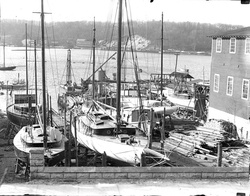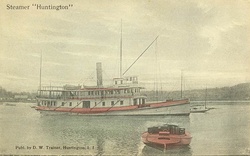19th Century Industry
Throughout the nineteenth century Huntington remained primarily a farming community, but several other industries also took root. Mills to grind grain, cut lumber and weave wool were established along the shoreline. The earliest mills were powered by small streams. But in 1752, Zophar Platt built a mill harnessing the power—and predictability—of the tides. The town’s first tide mill stood on the west shore of Huntington Harbor. Today’s Mill Dam Road runs along the embankment built to capture the tide. A second tide mill was built in Centerport. The third built further up Huntington Harbor still stands in Lloyd Harbor.
A pottery was established on the east shore of Huntington Harbor where a succession of owners produced a variety of stoneware and earthenware goods. Local clay was also used in nineteenth century Huntington’s biggest industry, brickmaking. Brickyards operated in West Neck (now Lloyd Harbor), East Neck (now Huntington Bay), Crab Meadow and Fresh Pond. Bricks by the millions were shipped to New York. Many Irish immigrants came to Huntington in the 1850s to work in the brickyards.
Sand mining was another lucrative extraction industry. Hundreds of thousands of cubic yards of sand were dug along the shore, especially in Eaton’s Neck, Asharoken and Northport, and shipped to New York City.
 Ships were built in every harbor, but Northport produced the greatest number—more than 180 vessels between 1814 and 1884. These ships were used in the coastwise trade bringing Huntington’s farm produce, bricks and sand to the city markets.
Ships were built in every harbor, but Northport produced the greatest number—more than 180 vessels between 1814 and 1884. These ships were used in the coastwise trade bringing Huntington’s farm produce, bricks and sand to the city markets.
In Cold Spring Harbor, a whaling company was established in 1838. Ships from the Cold Spring Harbor Whaling Company traveled as far as the Bering Sea in search of their prey. Whales were harvested for their oil, which was used for fuel. The whales’ bones and baleen were also put to good use. The whaling company did not survive the advent of petroleum.
In local waters, bay men harvested oysters, clams, lobster and finfish. Commercial fishing is now Huntington’s oldest industry.
Huntington also produced the poet of the nineteenth century—Walt Whitman. Huntington’s most famous resident was born in West Hills in 1819. His family moved to Brooklyn when he was a child but he returned to Long Island as a young man. He taught in various local schools and at the age 19 he founded The Long-Islander newspaper, which is still published.
Southside residents felt disenfranchised from the business affairs of the Town because the population along the north shore was greater than along the south shore. This dissatisfaction, which had been building since before the Civil War, finally led to the creation of the Town of Babylon in 1872.

Regular steamboat service to New York City was established in the 1840s. The arrival of the Long Island Rail Road in 1867 had a tremendous impact on the town. Not only did the railroad make city markets more accessible for Huntington produce, it also made Huntington more accessible to New Yorkers. In addition, the railroad created new settlements because the track was not laid near established village centers. The communities of Huntington Station, Greenlawn and East Northport trace their roots to the railroad.